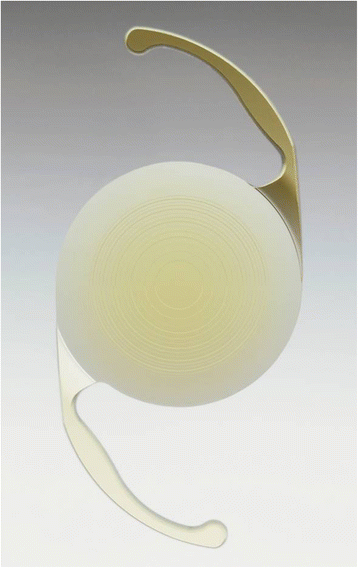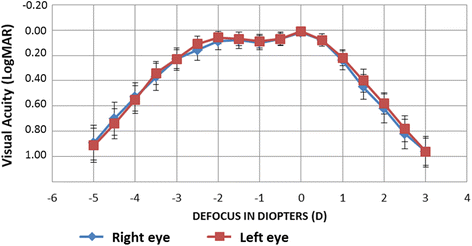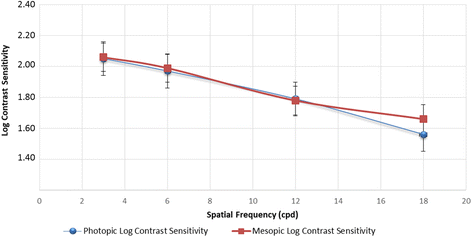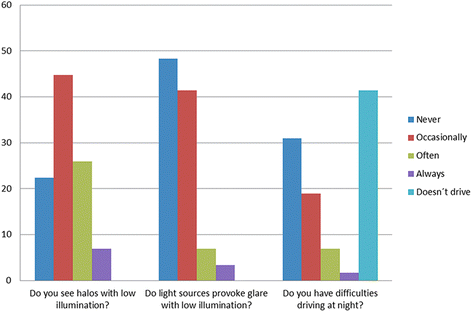Short term visual outcomes of a new trifocal intraocular lens
- PMID: 28514944
- PMCID: PMC5436431
- DOI: 10.1186/s12886-017-0462-y
Short term visual outcomes of a new trifocal intraocular lens
Abstract
Background: Today, patients often expect to achieve spectacle independance after cataract surgery. New trifocal intraocular lenses have been developed to try and fullfill this demand. The purpose of this study is to report the short-term visual outcomes of a new trifocal intraocular lens (AcrySof PanOptix™).
Methods: Consecutive adult patients undergoing cataract surgery with bilateral implantation of the study intraocular lens in a private practice clinic were considered for inclusion. Exclusion criteria were the presence of other ocular pathologies or preoperative astigmatism >1.5 diopters (D). Patients with intraoperative complications were excluded from analysis. One month after surgery patients underwent: monocular defocus curve; monocular and binocular uncorrected visual acuity in photopic and mesopic conditions, for far (4 m), intermediate (60 cm) and near (33 cm) distances and binocular contrast sensitivity. Patients completed a visual satisfaction questionnaire between 9 and 12 months after surgery.
Results: One hundred and sixteen eyes of fifty-eight patients receiving bilateral implantation of the study intraocular lens were analysed. Mean binocular uncorrected visual acuity in photopic conditions was 0.03 LogMAR for far, 0.12 for intermediate and 0.02 for near distances. All patients achieved a binocular uncorrected visual acuity better than 0.3 LogMAR (20/40 Snellen equivalent) for distance and near vision and 94.8% of patients for intermediate vision. Mesopic binocular uncorrected visual acuity values were similar to photopic values. The monocular defocus curves showed that the best visual acuity was reached at a vergence of 0.00D. Visual acuity dropped slightly at -1.00D and peaked again at -2.00D. Visual acuities better than 0.2 LogMAR were maintained between -2.50D and +0.50D. Contrast sensitivity was high and similar in photopic and mesopic conditions. As regards patient-evaluated outcomes, only 2 patients (3.4%) were fairly dissatisfied with their sight after surgery. Three patients (5.1%) reported the need for spectacle correction for certain activities. All other patients (94.8%) reported never using spectacle correction.
Conclusions: The PanOptix trifocal IOL provides good short-term visual outcomes, with good intermediate performance and excellent patient-reported satisfaction. The similar values achieved in mesopic and photopic conditions in binocular uncorrected visual acuity and contrast sensitivity suggest low pupillary dependence for light distribution.
Trial registration number: ISRCTN60143265 , retrospectively registered on the 24th of April 2017.
Keywords: Cataract surgery; Multifocal intraocular lens; Trifocal intraocular lens.
Figures






Similar articles
-
AcrySof IQ PanOptix Intraocular Lens Versus Extended Depth of Focus Intraocular Lens and Trifocal Intraocular Lens: A Clinical Overview.Asia Pac J Ophthalmol (Phila). 2019 Jul-Aug;8(4):335-349. doi: 10.1097/APO.0000000000000253. Asia Pac J Ophthalmol (Phila). 2019. PMID: 31403494 Free PMC article. Review.
-
Trifocal Intraocular Lens Implantation to Treat Visual Demands in Various Distances Following Lens Removal.Am J Ophthalmol. 2016 Jan;161:71-7.e1. doi: 10.1016/j.ajo.2015.09.030. Epub 2015 Oct 23. Am J Ophthalmol. 2016. PMID: 26432565
-
Comparison of a trifocal intraocular lens with a +3.0 D bifocal IOL: results of a prospective randomized clinical trial.J Cataract Refract Surg. 2015 Aug;41(8):1631-40. doi: 10.1016/j.jcrs.2015.08.011. J Cataract Refract Surg. 2015. PMID: 26432120 Clinical Trial.
-
Visual function after implantation of a diffractive aspheric trifocal intraocular lens.Eur J Ophthalmol. 2016 Aug 4;26(5):405-11. doi: 10.5301/ejo.5000741. Epub 2016 Jan 18. Eur J Ophthalmol. 2016. PMID: 26797852
-
Trifocal intraocular lenses versus bifocal intraocular lenses after cataract extraction among participants with presbyopia.Cochrane Database Syst Rev. 2020 Jun 18;6(6):CD012648. doi: 10.1002/14651858.CD012648.pub2. Cochrane Database Syst Rev. 2020. Update in: Cochrane Database Syst Rev. 2023 Jan 27;1:CD012648. doi: 10.1002/14651858.CD012648.pub3. PMID: 32584432 Free PMC article. Updated.
Cited by
-
The REVIVE Study: Long Term Outcomes of a Novel Non-Diffractive Extended Vision IOL versus Monofocal Control IOL.Clin Ophthalmol. 2022 Nov 28;16:3945-3950. doi: 10.2147/OPTH.S390380. eCollection 2022. Clin Ophthalmol. 2022. PMID: 36466083 Free PMC article. Clinical Trial.
-
Evaluation of Vision-Related Quality of Life After Unilateral Implantation of a New Trifocal Intraocular Lens.Beyoglu Eye J. 2022 Aug 5;7(3):167-172. doi: 10.14744/bej.2022.75768. eCollection 2022. Beyoglu Eye J. 2022. PMID: 36185989 Free PMC article.
-
Subjective Perception Of Trifocal IOL Performance, Including Toric Models.Clin Ophthalmol. 2019 Oct 2;13:1955-1961. doi: 10.2147/OPTH.S223062. eCollection 2019. Clin Ophthalmol. 2019. PMID: 31631963 Free PMC article.
-
Comparison of visual outcomes of a diffractive trifocal intraocular lens and a refractive bifocal intraocular lens in eyes with axial myopia: a prospective cohort study.BMC Ophthalmol. 2022 Oct 20;22(1):407. doi: 10.1186/s12886-022-02626-1. BMC Ophthalmol. 2022. PMID: 36266642 Free PMC article.
-
AcrySof IQ PanOptix Intraocular Lens Versus Extended Depth of Focus Intraocular Lens and Trifocal Intraocular Lens: A Clinical Overview.Asia Pac J Ophthalmol (Phila). 2019 Jul-Aug;8(4):335-349. doi: 10.1097/APO.0000000000000253. Asia Pac J Ophthalmol (Phila). 2019. PMID: 31403494 Free PMC article. Review.
References
-
- Braga-Mele R, Chang D, Dewey S, Foster G, Henderson BA, Hill W, Hoffman R, Little B, Mamalis N, Oetting T, Serafano D, Talley-Rostov A, Vasavada A, Yoo S. ASCRS cataract clinical committee. Multifocal intraocular lenses: relative indications and contraindications for implantation. J Cataract Refract Surg. 2014;40:313–322. doi: 10.1016/j.jcrs.2013.12.011. - DOI - PubMed
-
- Cochener B, Vryghem J, Rozot P, Lesieur G, Chevalier JP, Henry JM, David T, Lesueur L, Gatinel D, Ganem C, Blanckaert J, Van Acker E, Heireman S, Ghekiere S. Clinical outcomes with a trifocal intraocular lens: a multicenter study. J Refract Surg. 2014;30:762–768. doi: 10.3928/1081597X-20141021-08. - DOI - PubMed
MeSH terms
LinkOut - more resources
Full Text Sources
Other Literature Sources
Medical
Research Materials
Miscellaneous

